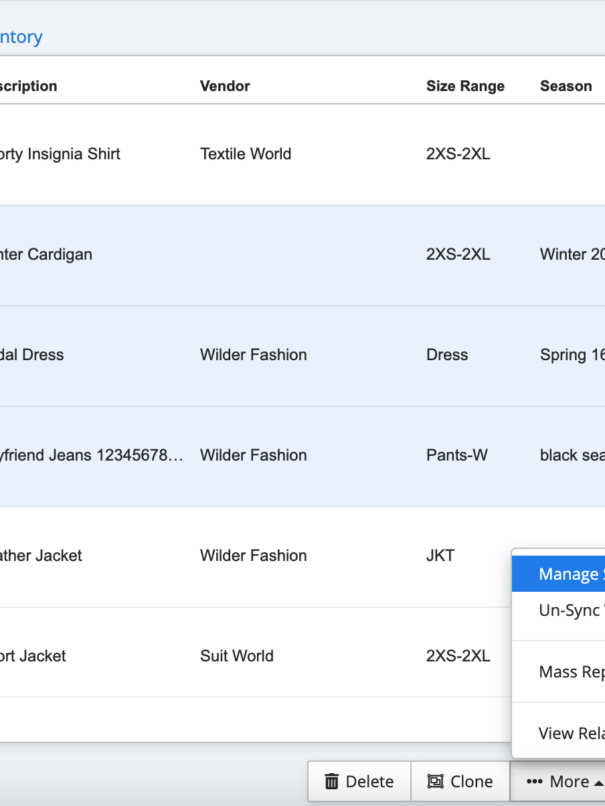Digital transformation in the apparel industry is becoming increasingly significant as companies adapt to rapidly changing market demands and consumer expectations.
Nowadays, apparel brands are going through complete overhauls. From the adoption of ERP systems to omnichannel and digital marketing approaches to streamline processes and boost profitability across the whole board.
The growing importance of digital-first strategies reshaping how consumers interact with apparel brands before, during, and after purchases, highlighting the need for brands to engage effectively across these platforms.
But how can you join this new wave and ensure you have future-proofed your brand and profitability for many years to come?
Below you will find a detailed analysis of how digital transformation in the apparel industry can be done hassle-free and with maximum efficiency with the right framework, in this case – SOCOI.
The SOCOI Framework
The SOCOI framework provides a strategic blueprint that structures the integration of digital technologies across various facets of business operations, emphasizing how these technologies empower consumers, enable personalized experiences, and drive sustainability and innovation across the entire value chain.
SOCOI, an acronym for See, Operate, Communicate, Optimize, and Improve, outlines a methodical approach to digital transformation, ensuring that companies can navigate this complex process with clarity and effectiveness.
SEE: Leveraging Data for Enhanced Visibility
Digital transformation in the apparel industry begins with the integration and analysis of data across all production stages, including the supply chain. In other words, being able to pinpoint what works and what doesn’t can seriously push a brand forward and make it stand out above the competition, especially when grappling with supply chain issues and rising costs of energy in textile manufacturing.
This is what led many apparel brands to start using manufacturing execution as well as ERP systems.
With a good MES and ERP, companies can achieve a complete view of their operations, including improving supply-chain speed and flexibility. This type of integration enables real-time monitoring and decision-making, improving operational visibility and efficiency across the supply chain.
So, if you too want to identify bottlenecks, optimize workflows, and reduce waste, leading to significant enhancements in production efficiency and enabling greater visibility and transparency across the supply chain, this is a crucial part of the framework.
With the right overview of your entire operations, including measuring impacts on sustainability in the value chain, you can pinpoint just where the bottlenecks are and improve on the already good aspects.
OPERATE: Industry-Specific Cloud Solutions
Focusing on the operation aspect of every apparel brand, it’s safe to say that the back-end processes can become quite difficult to handle. This is why many apparel brands focus on this aspect.
As mentioned, adopting cloud-based enterprise resource planning (ERP) systems tailored for the apparel industry can streamline numerous processes, from inventory management to customer relations.
These systems support the unique needs of the sector by providing scalability, real-time data access, and integration capabilities. ERP software facilitates smoother transitions to digital environments, reducing IT overheads and enhancing data security.
By automating core operations, these systems enable manufacturers to focus on strategic growth and innovation. Additionally, cloud-based ERP systems are instrumental in optimizing the fashion supply chain, enhancing data security, and scalability, and offering real-time data access, which is crucial for the dynamic nature of fashion retail.
COMMUNICATE: Streamlining Communication Channels
As businesses expand, communication becomes quite difficult to facilitate.
In a nutshell, effective communication is crucial for maintaining seamless operations across various departments and with external partners. Tools like electronic data interchange (EDI) and advanced CRM platforms help in establishing clear and consistent communication channels.
These technologies ensure that all stakeholders are aligned, which is essential for managing complex supply chains and customer relationships. They also help in reducing errors and misunderstandings, thereby enhancing overall operational efficiency and partner relationships.
OPTIMIZE: Advanced Forecasting and Fashion Supply Chain Inventory Management
Advanced forecasting techniques with AI and machine learning can significantly enhance inventory management by analyzing market trends.
Businesses that are seeking to enjoy the full benefits of digital transformation in the fashion industry are looking for ways to boost their operations, whether that is via using generative AI tools to give fashion garments better descriptions or AI chatbots to reply to customer queries.
In addition to that, these technologies analyze historical data and predict future apparel trends, allowing companies to adjust production schedules and inventory levels dynamically based on real-time analysis of market trends. This includes understanding the impact of market trends on the fashion industry and utilizing big data and analytics to respond to these trends effectively.
This proactive approach prevents overproduction and understocking, aligning product availability with market demand.
By optimizing inventory management, businesses can reduce holding costs, increase turnover rates, and improve customer satisfaction.
IMPROVE: Automation of Manual Processes
Automation is key to increasing productivity and reducing errors in the apparel manufacturing process. For apparel businesses that are looking to effortlessly improve and enjoy the digital transformation in the apparel industry to the fullest, automation can take a business to a whole new level.
Automating tasks such as bills of materials (BOM) creation, component tracking, and quality control checks can streamline operations and minimize the risk of human error. These improvements not only save time but also enhance the overall quality of the output.
By implementing automation, companies can ensure that their processes are more reliable, efficient, and capable of scaling as the business grows. Digital innovations, including automation technologies, are transforming the apparel manufacturing process by reducing errors and increasing productivity.
Why You Should Follow a Fashion Digital Transformation Framework
The importance of digital transformation cannot be overstated. It is essential for businesses seeking to stay competitive and relevant.
Implementing a structured digital transformation strategy framework, such as the SOCOI model, offers significant advantages by guiding organizations through the complexities of digital adoption and ensuring a smooth transition in the digital era.
Embracing digital fashion is becoming increasingly crucial for fashion brands aiming to remain competitive and relevant in the rapidly evolving digital landscape. The shift towards digital fashion, powered by advancements in AI, cloud computing, AR/VR, and blockchain, is transforming the fashion industry into a digital platform industry. Fashion brands must adapt to this change by optimizing their value chains, promoting sustainability, diversity, inclusivity, and innovation, and enhancing the customer experience through digital transformation. This strategic move not only addresses changing consumer expectations and behavior but also navigates the challenges and opportunities presented by the digital economy, ensuring a cohesive and personalized brand experience across multiple channels.
Framework Benefits
Using a structured digital transformation framework will provide you with a roadmap, in which you can follow specific strategies and steps that will, eventually take you to your goal.
Here are some major reasons why you should always follow a framework when your plan is to go digital.
Alignment with Strategic Goals
Adopting a framework ensures that digital transformation efforts are consistently aligned with the company’s strategic goals, particularly in optimizing the value chain for greater efficiency and competitiveness. This alignment is crucial in the digitalization of the fashion industry, where each step of the value chain can be revolutionized for improved efficiency, sustainability, and customer-centricity. By focusing on the value chain, businesses can ensure that digital innovations are integrated at every part of the apparel value chain, enhancing transparency, sustainability, and compliance within the value chain structure.
This strategic approach helps in making informed decisions about which technologies to invest in, ensuring that each technological upgrade or implementation not only drives the business closer to achieving its long-term objectives but also optimizes the value chain. By maintaining this alignment, organizations can avoid common pitfalls such as investing in trendy technologies that offer limited value to their specific business needs. Furthermore, this strategic alignment helps in clearly defining metrics for success, enabling organizations to measure the impact of digital initiatives against their strategic objectives and the efficiency of the value chain.
Enhanced Operational Efficiency
Digital transformation frameworks like the SOCOI one emphasize the integration of digital tools across various facets of business operations, from logistics and manufacturing to marketing and customer relations. This integration typically leads to significant improvements in operational efficiency.
By facilitating the integration of online and offline channels, digital transformation frameworks enhance operational efficiency across the business, ensuring a seamless connection between digital and physical sales channels. This is crucial for companies looking to leverage the advantages of both online and offline sales, from the migration of offline sales to e-commerce to the gradual return of offline traffic, especially noted in markets like China.
Automated processes reduce the need for manual intervention, decrease the likelihood of errors, and increase the speed of operations. For example, by automating data entry processes, companies can free up employee time for more complex tasks that add greater value. Moreover, digital tools can provide deeper insights into operational performance, allowing businesses to optimize their processes continuously.
Risk Management
Digital transitions come with a set of risks, including cyber threats, data breaches, and the challenges of change management. A well-defined digital transformation framework provides a blueprint for navigating these risks. It includes establishing robust cybersecurity measures, ensuring compliance with data protection regulations, and creating contingency plans to handle potential disruptions.
By following a structured approach to risk management, organizations can protect their digital infrastructure, safeguard their data, and maintain trust with their customers and stakeholders.
Employee Engagement and Training for Digital Fashion Brands
A good and all-encompassing framework addresses these needs by incorporating training and development strategies that prepare employees for new technologies and methodologies essential for digital marketing.
This training is crucial for equipping employees with the skills needed to leverage digital technologies, analytics, and technological developments to deliver personalized customer experiences, thereby improving conversion rates and revenues across multiple channels.
Furthermore, involving employees in the transformation process, with a focus on digital marketing strategies, can lead to higher job satisfaction and better adaptation to new roles. It fosters a culture of continuous learning and innovation, which is crucial for the long-term success of any digital strategy, especially in today’s digital landscape where digital marketing plays a pivotal role.
Conclusion
Digital transformation in the fashion industry has become quite common and more and more brands are looking to both future-proof their businesses and ensure profitability.
A well-defined digital transformation strategy framework is essential for businesses aiming to successfully navigate the complexities of modern technology and market dynamics.
By following a structured approach like SOCOI, companies can ensure that their digital initiatives align with strategic business goals, enhance operational efficiency, and prepare them for future challenges and opportunities.







